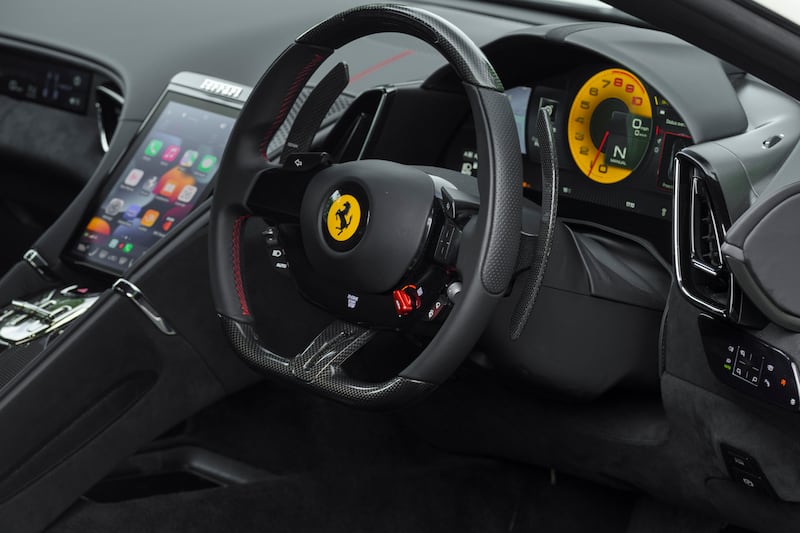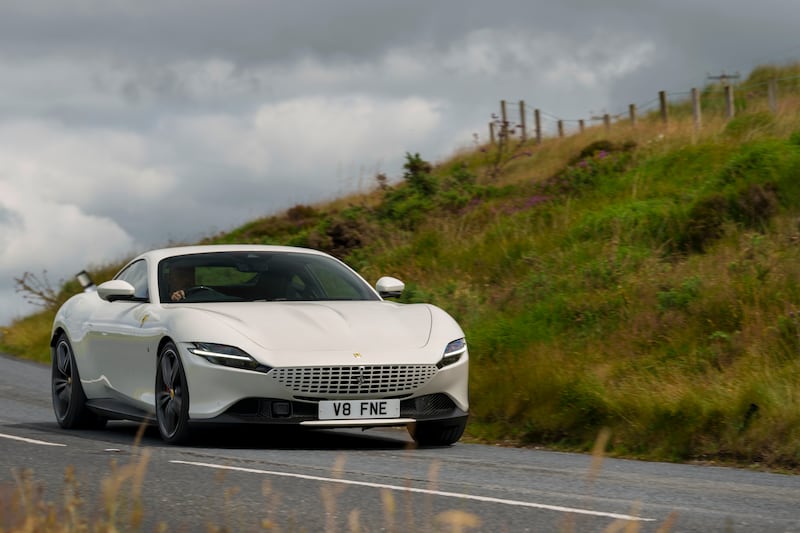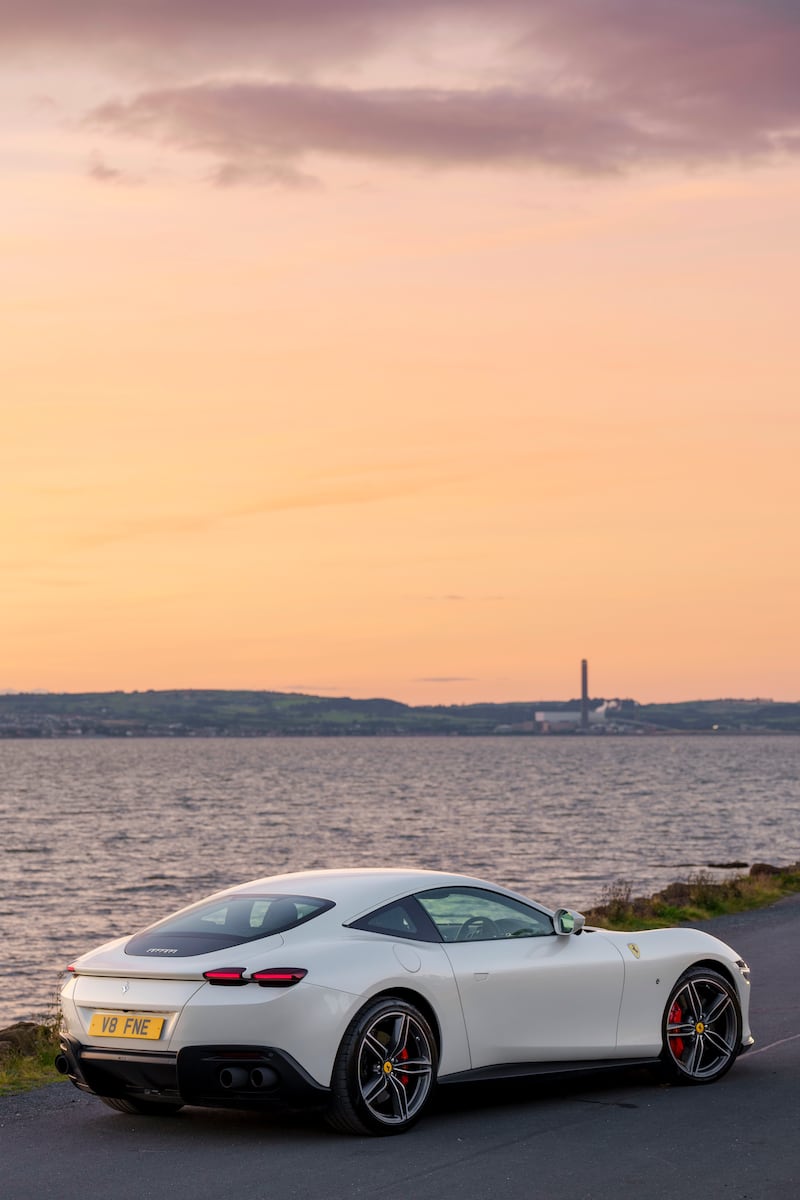Remember Ferrari this way. Not the man – Enzo’s legacy is complex at best, tumultuous in all of his business, racing and personal lives. Nor the racing team. All teams in all sports have fluctuations in form and differential success, but Ferrari more than any other seems to swoop endlessly from dizzying highs to calamitous lows. No, remember Ferrari the car-making company this way. An open road. An impossibly low-slung shape. A sound that rings and rattles around your eardrums long after it has passed.
Ferrari, as is almost every car manufacturer at the moment, is at a turning point. It is almost without question the most glamorous of car brands, and even more so than the likes of Rolls-Royce and Porsche; it’s instantly recognised by almost anyone. If a conventional car, however good, can be dismissed by most as a mere system of getting from A to B, then a Ferrari is clearly something else. It is a passion play, an opera on wheels.
Will that change in the future? Ferrari will later this year finally succumb to the SUV virus and launch a taller, high-riding model currently called (not without controversy but apparently without irony) the Purosangue, or Pure Blood. It will have a mighty, presumably noisy, V12 engine in the grand Ferrari tradition, but will it be embraced by the Ferrari faithful? Old man Enzo would doubtless have been quite happy about it – the profit margins from big SUV sales would have been endlessly funnelled to his true love: his racing team.
Electric cars, though? By the end of this decade, Ferrari wants about 40 per cent of its total sales to be made up of battery-electric vehicles, while the rest of the line-up will have electric power of some kind in the form of hybrid and plug-in hybrid engines, plus a handful of old-school combustion units running on notional carbon-neutral e-fuels. Famously, responding to criticism of the build quality of his cars, Enzo Ferrari once proclaimed: “I don’t care if the door gaps are straight. When the driver steps on the gas I want him to s**t his pants.”
While the instant-on acceleration of electric motors may well achieve that bowel-evacuating status, it will be hard and possibly impossible for those motors to achieve the legendary status of Ferrari’s dirty old petrol engines.
Even this one is pretty remarkable, and it’s just about the lowest-ranked Ferrari engine you can buy. By “this” I mean the 3.9-litre, twin-turbo V8 engine that’s nestling in the engine bay of the Roma I’ve just sat into. In other applications, this engine is ludicrously powerful. In the F8 Tributo, it develops 710hp. Here in the Roma, it has a “mere” 620hp, although with a claimed 0-100km/h time of just 3.4 seconds, you won’t hear me complaining about a lack of power. It’s come to something, though, when a Ferrari V8 is out-gunned by a Ferrari V6. The V6 hybrid in the Ferrari 296 GTB – similar in size to the Roma but like the F8, it’s mid-engined – has a combined 818hp.
The Roma, though, is not about setting lap times. That engine – gorgeous red crackle cam covers and all – is set behind the front wheels, making this a front-mid-engined car, but it’s still focused largely on comfort and ground-covering. It is, in every way, a classic GT car, made for crossing continents and inspired by the likes of the 250 GT Lusso and 330 GTE from the 1960s when getting to Milan before day’s end meant V12s and mountain passes, rather than Ryanair and lost luggage.
We won’t be driving to Milan today, alas. Instead we’re driving from Belfast to Belfast, via the Sperrin mountains and the north coastal road that loops its way over to the Giant’s Causeway. Why? Because we can, and possibly because Ferrari wants to remind us that the Roma exists.

It’s an unusual car, the Roma because apparently its owners actually drive it. According to Charles Hurst, this island’s only Ferrari dealer, 16 Romas have been sold with Irish or Northern Irish number plates, and they are frequently used as daily drivers. That goes against the Ferrari norm of new cars often being squirrelled away and kept only for high-day excursions, or just as often not driven at all and merely kept as an investment. The Roma, then, is the everyday Ferrari if such a concept can be imagined.
You slip rather than clamber into the low-set cockpit, and quickly find that the front seats are wonderfully comfortable and the back seats are essentially non-existent. Think of them as a leather-lined adjunct to the small boot. For two people, the Roma is eminently practical, but a family car it ain’t.

The dashboard sweeps around your hips, with digital dials in front of you (always fronted by a large rev counter whose colour you can change at a whim). Almost all of the major controls and switches are grouped on the carbon-rimmed steering wheel, F1 style. Yes, even the indicators as conventional column stalks would get in the way of the huge carbon-fibre paddles that allow you to take manual control of the eight-speed gearbox. Sadly, the days of true manual gearbox Ferraris are gone, but at least the selector for this dual-clutch unit pays small homage to the chrome-gated changes of its predecessors.
The steering wheel itself has its own touchscreen, or at least a touch-sensitive panel that flashes up buttons for some functions but the most important button is physical. It’s a little red switch, tactile in the extreme, called the Manettino, and it allows you to choose between Comfort, Sport, and Race modes. A press of the centre of the button also allows you to pick the “bumpy road” setting for the adaptive suspension dampers – a major necessity on Irish roads, ar ndóigh.
The roads that loop out of Belfast, into Tyrone and Fermanagh and up over the Sperrins are arguably closer in spirit to the roads of continental Europe back in the 1950s and 1960s, when the Ferrari GT car was born. Enzo only sold cars so that he had the profits to go racing (hence his interesting approach to customer service…) but it wasn’t long after Ferrari road-car-making kicked off in 1948 that it became clear that selling tarted-up racing chassis with number plates wasn’t going to cut it. So were born those wonderful GT cars, with evocative names such as Lusso, SuperAmerica, California. Does the Roma name seem a touch more parochial? Maybe so, but this is still an astonishing car.
Of course it’s fast. What did you expect? This Roma may not have the firepower of other Ferraris, but compared with any normal road car, it is shatteringly fast. No road in this country can accommodate a Roma at full noise – for that you need a race track or an Autobahn, or just a total lack of common sense or care for your fellow man. That said, rather thankfully, this is not a car that needs to be driven at silly speeds for it to be enjoyable. Indeed, on a loop up over the Sperrins, on the sort of tight and twisty almost-single-track roads that you’d assume would be anathema to an expensive car like this (but which are actually not entirely unlike some of the back roads near Ferrari’s Maranello headquarters) the Roma absolutely comes alive.

With the bumpy road setting dialled in, it’s flexible and fluid enough to cope with the heaving, bucking tarmac surface. It’s also comically agile. The old logic that a front-engined GT could never be as agile as a mid-engined sports car is taken by the Roma, torn up, ingested into its eight cylinders, burned and spat out of the exhausts. The steering is fast and responsive but impressively never nervous, and although there can occasionally be a slight sensation of slack between your inputs and the movements of that low nose, the Roma can be pin-point aimed and turned through even the most vicious of switchbacks. Essentially, this is a ground-hugging cruise missile that you aim at the horizon, sighting between the tall humps of the front wheel arches, which intrude into your line of vision like as if your splayed knees were making peaks in the bedclothes.
Okay, so the Roma lacks the ultimate precision of the likes of the F8 or 296, but I’ll take that trade-off for good all-round visibility (even parallel parking this Ferrari is relatively easy), a sensible ride height and a sense of comfort on longer motorway sections. This is a Ferrari that can charge and stampede with the best of them, but aside from too much tyre roar and an annoying tendency for the exhaust system to boom into the cabin at a cruise, it’s also comfy and sensible enough to be a daily driver.
Of course, at 11 litres per 100km, not many will have the resources to run a car such as this as their daily driver, but then with a notional €320,000 Irish price tag (and that’s before you dip into the endlessly ruinous options list) it’s doubtful that any Roma owner has been much inconvenienced by recent fuel price rises.

That does kind of raise the question of relevance. With high consumption and emissions (255g/km), and its exclusive nature, one might wonder if a car such as this – or any Ferrari – really has a place in the modern world and its myriad challenges. Then again, even a troubled world needs beautiful things and this Roma is most certainly beautiful. Many have pointed out a visual similarity to the Aston Martin Vantage, but while their silhouettes might match, the Ferrari is lower and more needle-nosed, and its detailing is far sexier (aside from the clunky box in the front bumper that houses the radar unit for the cruise control).
We’ve risen up mountains again before dropping down to the coast and zipping along next to a bright blue Atlantic to Larne, before the final motorway miles back into Belfast. The Roma has performed faultlessly, as happy sniffing out apexes up in the hills and down here on the coast as it has been picking a path through tour coaches and finding parking spaces when coffee seemed more important than mileage. The bellow of its mighty V8 – a raspier and higher-pitched sound than the more rumbly tones of rival engines from Porsche, Mercedes or BMW – is as intoxicating as the low-slung lines, and while it’s not a “proper” Ferrari V12, the Roma is fast enough, pretty enough and talented enough to rank among the best cars Enzo’s eponymous company has ever made.
How the Roma will be finally remembered is yet to be written. As a fin de siècle closing chapter on petrol power, a last hurrah of the great GT? Or a V8 bookmark as Ferrari turns a new page, and opens a glorious new electric chapter? Perhaps, for the moment, it’s better not to care and to simply enjoy the drive.



















